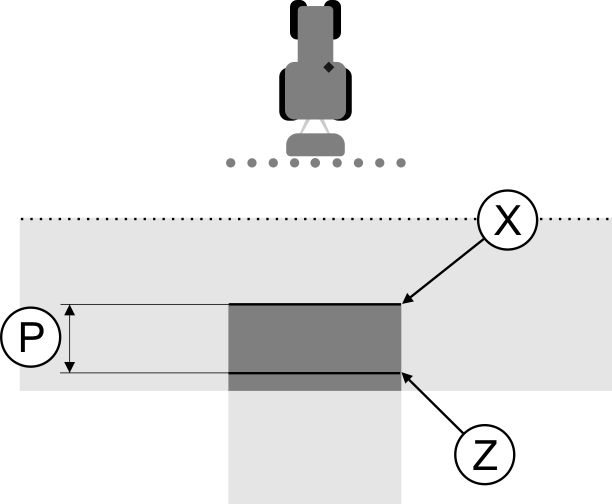Changing the delay parameter
You must now adjust the "Delay on start" and 'Delay on stop" parameters.
Procedure
- 1.
- Alter the parameters using the following rule of thumb:
- If the sprayer switches on too late, it needs more time. The delay period must be extended.
- If the sprayer switches on too soon, it needs less time. The delay period must be reduced.
- 2.
- Calculate a new value for the delay parameter.
Perform this step separately for the "Delay on start" or "Delay on stop"
If the sprayer switches on or off too late:
Extend the current delay period by the correction value
If the sprayer switches on or off too early:
Reduce the current delay period by the correction value
Example
A sprayer traveled at a speed of 8 km/h. This corresponds to 0.22 cm/ms.
After the second travel, the distance P was measured. The distance was 80cm.
The "Delay on stop" parameter is currently set to 450ms.
The sprayer was switched off too late when traveling over an area where the product has been already applied. Point Z lied in front of Point X along the direction of travel. The lines were marked as in the illustration below:
When travelling over the area where the product has been already applied, the sprayer switched off too late
- 1.
- Calculate the correction value:
[Distance P]: [Speed of sprayer] = Correction value
80 : 0,22 = 364
- 2.
- Calculate a new value for the delay parameter.
As the sprayer switches off too late, "Delay on stop" must be increased by the correction value:
364 (correction value) + 450 (set "Delay on stop") = 814 (new "Delay on stop")
- 3.
- Insert value 814 for the "Delay on stop" parameter.
Example
A sprayer traveled at a speed of 8 km/h. This corresponds to 0.22 cm/ms.
After the second travel, the distance P was measured. The distance was 80cm.
The "Delay on stop" parameter is currently set to 450ms.
The sprayer switched off too early when traveling over an are where the product has been already applied. Point Z lied in front of Point X along the direction of travel. The lines were marked as in the illustration below:
When traveling over an area where the product has been already applied, the sprayer switched off too early.
- 1.
- Calculate the correction value:
[Distance P]: [Speed of sprayer] = Correction value
80 : 0,22 = 364
- 2.
- Calculate a new value for the delay on stop parameter.
As the sprayer switches on or off too early, "Delay on stop" must be decreased by the correction value:
450 (set "Delay on stop") - 364 (correction value) = 86 (new "Delay on stop")
- 3.
- Insert value 86 for the "Delay on stop" parameter.



